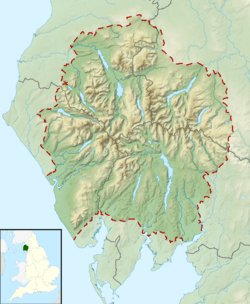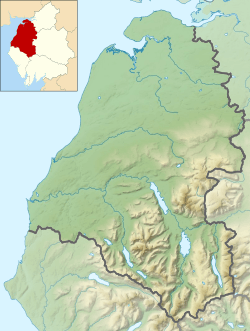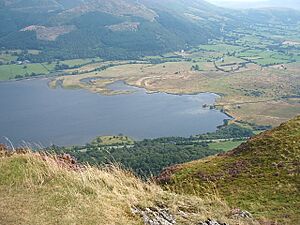Bassenthwaite Lake facts for kids
Quick facts for kids Bassenthwaite Lake |
|
|---|---|
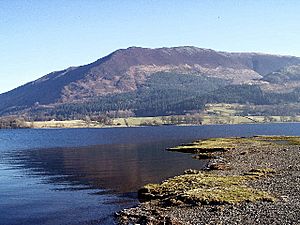
View from Blackstock Point
|
|
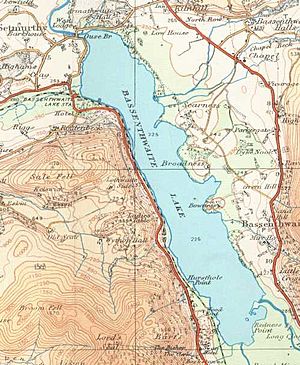
Map (1925)
|
|
| Location | Lake District |
| Coordinates | 54°39′N 3°13′W / 54.650°N 3.217°W |
| Primary inflows | River Derwent Newlands Beck |
| Primary outflows | River Derwent |
| Catchment area | 96.5 sq mi (250 km2) |
| Basin countries | United Kingdom |
| Max. length | 4 mi (6.4 km) |
| Max. width | 0.8 mi (1.3 km) |
| Surface area | 1.98 sq mi (5.1 km2) |
| Max. depth | 70 ft (21 m) |
| Shore length1 | 11.3 mi (18.2 km) |
| Surface elevation | 223 ft (68 m) |
| Islands | 0 |
| 1 Shore length is not a well-defined measure. | |
Bassenthwaite Lake is one of the biggest lakes in the English Lake District. It is long and thin, about 4 miles (6.4 km) long and 0.75 miles (1.2 km) wide. Even though it's long, it's quite shallow, with its deepest point being around 70 feet (21 m).
This lake is special because it's the only major body of water in the Lake District that actually has "Lake" in its name! Other large waters are called "waters" (like Derwentwater), "meres" (like Windermere), or "tarns" (like Dock Tarn). The River Derwent flows into and out of Bassenthwaite Lake. You can find the lake at the bottom of Skiddaw mountain, close to the town of Keswick.
A main road, the A66, runs along the western side of the lake. Many people stop at viewpoints along this road to take photos or watch for amazing birds like ospreys.
Contents
How Bassenthwaite Lake Formed
Just like other lakes in the Lake District, Bassenthwaite Lake was shaped by glaciers. These huge sheets of ice carved out the valley during the last Ice Age.
Bassenthwaite Lake is connected to Derwent Water by the River Derwent. There's a flat, muddy area about 3 miles (4.8 km) wide between the two lakes. Some people think that Bassenthwaite Lake and Derwent Water were once one much larger lake. Over time, the river brought in mud and dirt, which filled in part of the original lake, creating the flat land we see today.
What's in a Name?
The name 'Bassenthwaite' comes from old words. It means "Bastun's clearing" or "Bastun's water." 'Bastun' was likely a person's name or nickname, meaning 'stick'. The word 'þveit' (pronounced 'thwaite') comes from Old Norse and means 'clearing' or 'common land'. So, the lake got its name from a nearby village that was once called "Bastun's water."
Amazing Wildlife at the Lake
Bassenthwaite Lake has the largest area of land draining into it compared to any other lake in the Lake District. A lot of this land is used for farming, which makes the lake a very rich place for different kinds of plants and animals to live.
Fish Species
The lake is home to many fish, including salmon, trout, pike, perch, minnow, dace, ruffe, and eel. The most common fish you'll find here is the roach. It's thought that roach were accidentally introduced by anglers who used them as live bait for pike fishing. Sadly, a special type of fish called the vendace used to live here but was declared extinct in the lake in 2001.
Birdlife Around the Lake
You might spot cormorants diving for fish in the lake. Herons are also often seen standing quietly by the water's edge, waiting to catch their next meal. A long time ago, in the early 1800s, there were reports of many heron nests in the nearby Wythop Woods.
Lake District Osprey Project
A really exciting thing happened in 2001: ospreys returned to nest in the Lake District after being away for over a hundred years! They chose to build their nests near Bassenthwaite Lake and have come back almost every year since. You can often watch these amazing birds and their families from special viewing spots at Dodd Wood. There's even a CCTV camera that shows them live at the Whinlatter Forest Visitor Centre.
Protecting the Lake
The quality of the water in Bassenthwaite Lake has faced some challenges. Things like too much mud settling in the lake and pollution from chemicals called phosphates have been problems. To help fix this, there's a big effort called the Bassenthwaite Lake Restoration Programme.
To stop too much mud from getting into the lake, more trees have been planted along the streams that flow into it. Also, people are encouraged not to cut down all the trees in an area (clear felling) because trees help hold the soil in place.
Phosphates are chemicals that can make too much algae grow in the water, which isn't good for the lake's health. The Environment Agency, which looks after nature, found that high levels of phosphates were coming from a wastewater treatment plant and a pumping station in Keswick. A water company, United Utilities, has been working on a large project to improve the sewer system. This project, which started in 2011, aims to remove more phosphates from the water before it reaches the lake, helping to make the water cleaner and healthier for everyone and everything that lives there.
Ancient History of the Area
The wide, flat areas of gravel between Derwent Water and Bassenthwaite Lake were a great place for early farming communities during the Neolithic period (the New Stone Age). Stone axes from this time have been found in the area, especially near Mossgarth in Portinscale. This shows that people lived and farmed here thousands of years ago!
Images for kids
-
Bassenthwaite Lake from the summit of Dodd


